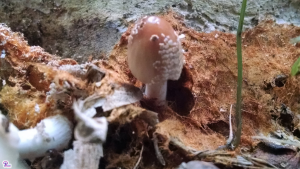#214: Coprinellus disseminatus
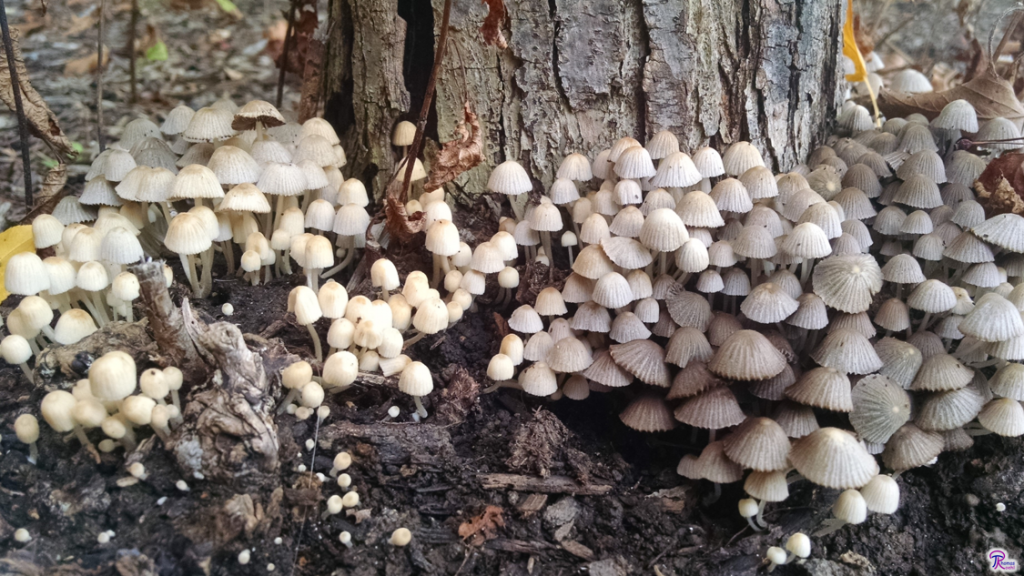
Coprinellus disseminatus forms thousands of tiny mushrooms at the bases of tree stumps. These two features alone make the mushrooms surprisingly easy to identify. Although the mushrooms are inky caps, they do not have gills that liquefy.
Coprinellus disseminatus is a tiny umbrella-like mushroom that makes up for its small stature by producing thousands of mushrooms at once. I found one stump last weekend that I estimate produced between 6,000 and 10,000 mushrooms. There were so many mushrooms so close together that from a distance they looked more like a single large crust fungus than lots of tiny mushrooms. C. disseminatus is also remarkable because it is an inky cap but its gills do not liquefy. You can actually get a spore print from this mushroom instead of a gooey black glob.1 Despite that, C. disseminatus disappears quickly like any other inky cap. Once, in my early days of mushroom hunting, I passed a stump with a few hundred C. disseminatus mushrooms in the morning. When I revisited it that afternoon, I found no traces whatsoever of the inky caps.
Description
The most noticeable feature of C. disseminatus is that it produces dense clusters of tiny mushrooms. Each mushroom is umbrella-shaped, with a thin central stipe and a dainty convex to bell-shaped pileus. The stipe can grow up to 4cm long but gets no more than a couple of millimeters thick. The largest pilei produced by C. disseminatus get up to 2cm across but most caps reach sizes of around 1cm across. Although the mushrooms grow very close together, their stipes are not fused; each mushroom arises from a separate and distinct base.1–4
Each mushroom’s cap begins as a tiny whitish to creamy oval. As it gets bigger it starts to open up, becoming convex. It also develops furrows or pleats that stretch from the margin to the center, stopping just short of the point above where the stipe attaches. The small circle at the very center of the pileus remains smooth throughout development. At this point, the mushroom darkens to yellowish brown or brownish, but stays lighter at the edges. You may notice that the pileus has a coating of small hairs or granules, although these tend to disappear as the mushroom matures. When fully mature, the pileus margin begins to flare out somewhat, making the pileus bell-shaped. Now, the pileus takes on a greyish hue beginning at the edges and working toward the center.1–4
Underneath the cap, the gills can be either attached to the stipe or free from it. The gills tend to be spaced fairly far apart, especially considering the mushroom’s size. When young, the gills are whitish but they soon darken to greyish and finally to blackish as the spores mature. Unlike most inky caps, the gills of C. disseminatus do not liquefy (“deliquesce”) as they mature.1–4
The stipe of C. disseminatus is rather boring. Not surprisingly, it is long, thin, and fragile. It is whitish and can be straight or curvy. Like other species of Coprinellus, the stipe is hollow. The stipe’s thickness remains the same throughout its length. C. disseminatus does not form a partial veil, so there is no ring on the stipe. However, the stipe is covered in tiny whitish hairs.1–4
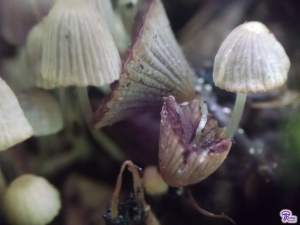
The gills of C. coprinus turn blackish but do not liquefy. Once it is done releasing spores, the mushroom quickly shrivels up and collapses.
Ecology
This mushroom grows on every continent except Antarctica and is common throughout much of its range.2 C. disseminatus appears on rotting wood and most often on rotting stumps and roots.1–4 I’ve only ever found C. disseminatus on tree stumps, so the fungus certainly has a preference for that habitat. The first time I found the mushroom it was growing on a living tree. That is not the fungus’ typical habitat but indicates that C. disseminatus is one of the first fungi to colonize a stump when the wood dies. You can find C. disseminatus from spring through fall.1–4 In my area, the mushroom was out in force last weekend thanks to all the recent rain.
Similar Species
C. disseminatus would be a difficult mushroom to identify if you found only a few of the mushrooms. There are many small mushrooms that fit the general description of C. disseminatus, most of which are inky caps and relatives in the genera Coprinellus, Coprinopsis, Parasola, and Psathyrella. Fortunately, the size and habitat of C. disseminatus easily separate it from all other lookalikes (at least, in North America). It is the only inky cap that 1) is small and 2) fruits on large chunks of wood.5 Of course, there are other features that make this mushroom stand out, including: fruiting in incredible numbers, non-liquefying gills, and a preference for tree stumps.
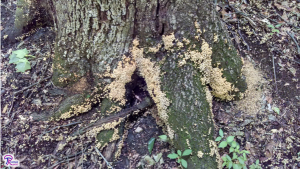
Although it is a tiny mushroom, you could easily imagine making a meal out of C. disseminatus thanks to its prolific fruiting. I estimate that there are at least 3,000 C. disseminatus mushrooms in this picture.
Edibility
This is one of the few small mushrooms fruits abundantly enough to be worthwhile collecting for a meal. And C. disseminatus is an edible mushroom! Unfortunately, the mushroom’s flesh is insubstantial and bland, so eating C. disseminatus is not particularly enjoyable.2–4 If you decide you want the unique experience of eating fistfuls of tiny mushrooms, go ahead and eat this one. C. disseminatus should be cooked first, so try sautéing the mushrooms with something that has a bit more flavor.
Taxonomy
C. disseminatus belongs in the Psathyrellaceae lineage of inky caps,6 which means it is related to coprinoid mushrooms (see FFF#177) in the genera Coprinopsis, Parasola, and Psathyrella but unrelated to the well-known inky caps in Coprinus such as the Shaggy Mane. C. disseminatus actually has a few common names, although they are not widely used. These include: “Non-Inky Coprinus,” “Little Helmets,” “Fairy Inkcap,” “Trooping Crumble Cap,” and a few other less common ones.2,3,7 I’ve never heard anyone use any of these, so the scientific name is probably the most commonly used name for the mushroom.
If you’ve been paying attention to the taxonomy section in FFF posts, you may notice something a little different about this one. It features a new taxonomic division: subkingdom. C. disseminatus belongs to the subkingdom Dikarya, which includes the divisions Ascomycota, Basidiomycota, and Entorrhizomycota.6,8 These first two should be familiar to you since they contain almost all mushrooms. The name Dikarya has been around for a while, but the fungus name database I use (Mycobank) only started including it in the classification scheme this week.
| Kingdom | Fungi |
| Subkingdom | Dikarya |
| Division (Phylum) | Basidiomycota |
| Subdivision (Subphylum) | Agaricomycotina |
| Class | Agaricomycetes |
| Subclass | Agaricomycetidae |
| Order | Agaricales |
| Family | Psathyrellaceae |
| Genus | Coprinellus |
| Species | Coprinellus disseminatus (Pers.) J.E. Lange6 |
This post is not part of a key and therefore does not contain enough information to positively identify any mushroom. When collecting for the table, always use a local field guide to identify your mushrooms down to species. If you need a quality, free field guide to North American mushrooms, I recommend Michael Kuo’s MushroomExpert.com. Remember: when in doubt, throw it out!
See Further:
http://www.mushroomexpert.com/coprinellus_disseminatus.html
https://www.first-nature.com/fungi/coprinellus-disseminatus.php
http://www.mykoweb.com/CAF/species/Coprinellus_disseminatus.html
Citations
- Kuo, M. Coprinellus disseminatus. MushroomExpert.Com (2008). Available at: http://www.mushroomexpert.com/coprinellus_disseminatus.html. (Accessed: 8th June 2018)
- O’Reilly, P. Coprinellus disseminatus (Pers.) J.E. Lange – Fairy Inky cap. First Nature Available at: https://www.first-nature.com/fungi/coprinellus-disseminatus.php. (Accessed: 8th June 2018)
- Emberger, G. Coprinellus disseminatus. Fungi Growing on Wood (2008). Available at: https://www.messiah.edu/Oakes/fungi_on_wood/gilled%20fungi/species%20pages/Coprinellus%20disseminatus.htm. (Accessed: 8th June 2018)
- Wood, M. & Stevens, F. California Fungi—Coprinellus disseminatus. The Fungi of California Available at: http://www.mykoweb.com/CAF/species/Coprinellus_disseminatus.html. (Accessed: 8th June 2018)
- Kuo, M. Coprinoid Mushrooms: The Inky Caps. MushroomExpert.Com (2008). Available at: http://www.mushroomexpert.com/coprinoid.html. (Accessed: 8th June 2018)
- Coprinellus disseminatus. Mycobank Available at: http://www.mycobank.org/Biolomics.aspx?Table=Mycobank&Rec=155752&Fields=All. (Accessed: 8th June 2018)
- Trooping Crumble Cap (Coprinellus disseminatus). iNaturalist.org Available at: https://www.inaturalist.org/taxa/56314-Coprinellus-disseminatus. (Accessed: 8th June 2018)
- Dikarya. Mycobank Available at: http://www.mycobank.org/BioloMICS.aspx?TableKey=14682616000000067&Rec=432186&Fields=All. (Accessed: 8th June 2018)

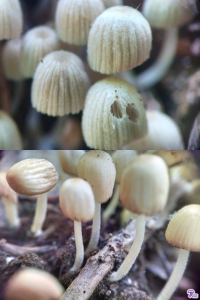
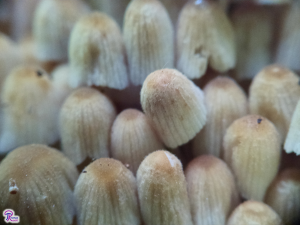
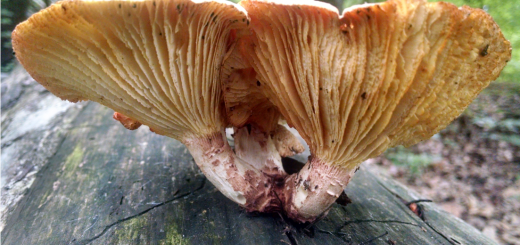

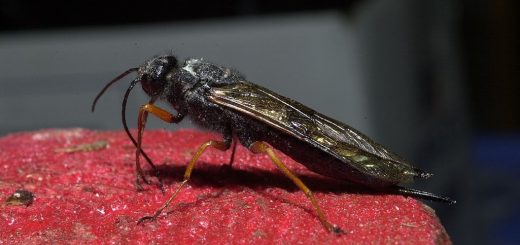





![#011: Characteristics of Kingdom Fungi [Archived]](https://www.fungusfactfriday.com/wp-content/themes/hueman/assets/front/img/thumb-small-empty.png)

